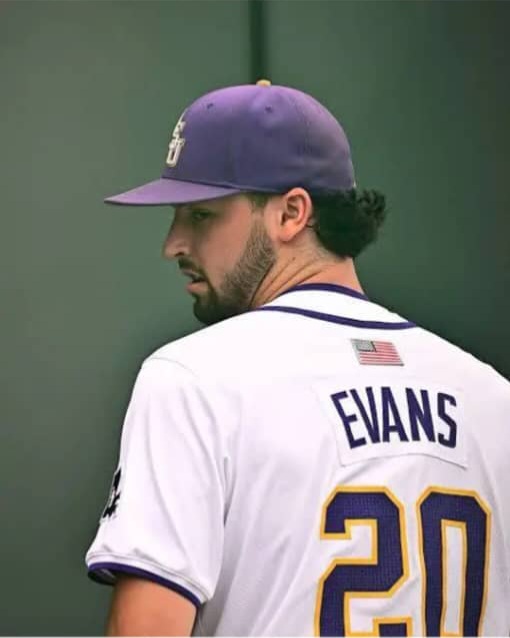OMAHA, Neb. — As LSU’s Tigers prepare to face Coastal Carolina in the College World Series finals, the roster reflects careful management of talent, particularly among its heralded freshmen. While LSU’s rotation and lineup shine brightest, some of its elite newcomers have been strategically held back—both to conserve their arms and to prioritize veteran depth in the clutch.
#### **Four‑Star Freshmen Take a Back Seat**
Entering the season with high expectations, LSU’s freshman cohort boasted elite talent, headlined by true freshman reliever **Casan Evans**. A Second-Team All-American with a mid‑90s fastball and a devastating changeup and slider, Evans found his way into LSU’s bullpen rotation during midweek and relief innings ([tigerdroppings.com][1], [new.cbssports.com][2]). Yet, despite his electric upside, he wasn’t deployed in Omaha’s pressure-cooker environment—Coach Jay Johnson opted instead for experienced arms ready for high-leverage postseason innings.
Similarly, freshman infielder/outfielder **Ethan Frey**, originally a high school catcher turned DH, has been a dynamic presence. With a .331 batting average and 13 home runs this season, his versatility at first base or corner outfield made him a key contributor ([andthevalleyshook.com][3]). However, in the College World Series, frey’s plate appearances have been limited to low-leverage spots late in games—underscoring a trend of conserving his potential for the fall season or even a shot in the pros.
Next up: two freshman arms who rarely grip a baseball during tournament games. **William Schmidt** and **Mavrick Rizy**, both second-year college hurlers, flashed mid‑90s heaters and promising control in SEC play. They were instrumental in regular-season series, but in Omaha they’ve sat on the bench as LSU leans on veterans like **Chase Shores**, **Kade Anderson**, and **Anthony Eyanson** for the starting nods and high-leverage bullpen stints ([en.wikipedia.org][4]).
Injury hasn’t been a factor; rather, it’s a calculated decision by Johnson to shield emergent arms. As the rotation deepens, maintaining availability for the fall and postseason tournaments appears to take priority over short-term deployment.
#### **Veteran Arms Carry the Load**
Coach Johnson’s philosophy—”Tough and Together”—has resonated throughout the season ([si.com][5]). In the CWS finals, that mantra crystallized via a potent veteran pitching duo:
* **Kade Anderson**, a redshirt junior returning from Tommy John surgery, delivered a 9‑strikeout shutout in Game 1, earning College World Series Most Outstanding Player honors ([mlb.com][6]). His complete-game performance set the tone for the Tigers and reinforced why LSU trusted him above all else.
* **Anthony Eyanson**, a junior transfer from UC San Diego and Second-Team All‑American, followed in Game 2. He notched nine strikeouts over 6⅓ innings, allowing just three runs and solidifying LSU’s rotation order ([si.com][7]).
Behind them, **Chase Shores**—a veteran reliever who recovered from Tommy John surgery—closed out Game 2 with triple-digit heat, fanning four in 2⅔ shutout innings to finish the season on a storybook note ([mrt.com][8]).
#### **Strategic Depth Over Flashy Freshman Performances**
The sidelining of freshmen like Evans, Schmidt, Rizy, and Frey isn’t due to injury but to opportunity cost:
* **Pitching Depth**: With two dominant weekend starters and a lockdown closer, LSU simply doesn’t have innings to spare. Using freshman arms only when necessary preserves them for longer-term roles.
* **Lineup Balance**: In high-stakes CWS play, LSU’s veteran hitters—Jared Jones, Derek Curiel, Chris Stanfield, and Steven Milam—offer proven production. Frey, while impressive, remains the reserve DH, stepping in selectively ([en.wikipedia.org][4], [si.com][9]).
* **Roster Management**: LSU’s springboard strategy is clear: rely on tested talent now to secure another title, and let freshmen grow on the backend where they’ll be needed most.
#### **LSU’s Plan: Win Now, Prep for Tomorrow**
This blend of clutch deployment and depth management speaks to Jay Johnson’s forward-thinking. With losses to the pros (Michael Braswell, Anthony Eyanson & Kade Anderson likely departing), and significant change ahead, guardrails around freshman production are deliberate ([andthevalleyshook.com][3]). By protecting their arms and tempering expectations for immediate impact, LSU cultivates sustainability.
Yet, when the Tigers emerge from Omaha with an eighth national championship, the sight of freshmen like Evans and Frey — still fresh, polished, and prospect-ready — will be a boon next spring. Their deferred deployment now may be tomorrow’s powerhouse advantage.
#### **Looking Beyond Coastal Carolina**
Should LSU close out Coastal Carolina, the message is clear: this program is as resilient as it is talented. The decision to sideline high-upside freshmen reflects maturity from coaching leadership, ensuring that immediate ambitions don’t eclipse long-term success.
As LSU’s dynastic run extends—two titles in three years—it becomes less about one series and more about structuring championship ecosystems. In that ecosystem, sidelined freshman talents are not casualties—they’re carefully nurtured variables awaiting their turn on the grand stage.
—
**Summary:** LSU’s Coastal Carolina series is being powered by experienced pitching and veteran lineup leaders. Behind the scenes, elite freshmen like Evans, Frey, Schmidt, and Rizy are being rested—not due to injury, but strategic foresight—preserving both arms and roles for future high-stakes games. In the grand calculus of championship baseball, sometimes the smartest move is knowing when not to move at all—and LSU’s roster management showcases exactly that.
